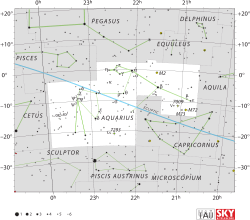38 Aquarii
From Wikipedia, the free encyclopedia

Location of 38 Aquarii (circled) | |
| Observation data Epoch J2000.0 Equinox J2000.0 (ICRS) | |
|---|---|
| Constellation | Aquarius |
| Right ascension | 22h 10m 37.48206s[1] |
| Declination | –11° 33′ 53.7754″[1] |
| Apparent magnitude (V) | +5.43[2] |
| Characteristics | |
| Spectral type | B5 III[3] |
| B−V color index | –0.12[4] |
| Astrometry | |
| Radial velocity (Rv) | +1.5[2] km/s |
| Proper motion (μ) | RA: +29.29[1] mas/yr Dec.: +8.76[1] mas/yr |
| Parallax (π) | 7.25 ± 0.33[1] mas |
| Distance | 450 ± 20 ly (138 ± 6 pc) |
| Details | |
| Radius | 5.6[5] R☉ |
| Surface gravity (log g) | 4.00[3] cgs |
| Temperature | 13,860[3] K |
| Metallicity [Fe/H] | –0.26[3] dex |
| Rotational velocity (v sin i) | 20[6] km/s |
| Other designations | |
38 Aquarii (e Aquarii, e Aqr, 38 Aqr) is the Flamsteed designation for a star in the equatorial constellation of Aquarius. It is a faint star but visible to the naked eye, with an apparent visual magnitude of +5.43.[2] The distance to this star, based upon parallax measurements, is around 450 light-years (140 parsecs).[1]
The spectrum of 38 Aquarii matches a stellar classification of B5 III.[3] A luminosity class of III indicates that this is an evolved giant star. It has 5.6[5] times the radius of the Sun and is spinning with a projected rotational velocity of 20 km/s.[6] The outer atmosphere of the star has a blue-white glow from an effective temperature of 13,860 K.[3]
References
- ↑ 1.0 1.1 1.2 1.3 1.4 1.5 van Leeuwen, F. (November 2007), "Validation of the new Hipparcos reduction", Astronomy and Astrophysics 474 (2): 653–664, arXiv:0708.1752, Bibcode:2007A&A...474..653V, doi:10.1051/0004-6361:20078357.
- ↑ 2.0 2.1 2.2 Wielen, R. et al. (1999), Sixth Catalogue of Fundamental Stars (FK6). Part I. Basic fundamental stars with direct solutions (35), Astronomisches Rechen-Institut Heidelberg, Bibcode:1999VeARI..35....1W.
- ↑ 3.0 3.1 3.2 3.3 3.4 3.5 Cenarro, A. J. et al. (January 2007), "Medium-resolution Isaac Newton Telescope library of empirical spectra - II. The stellar atmospheric parameters", Monthly Notices of the Royal Astronomical Society 374 (2): 664–690, arXiv:astro-ph/0611618, Bibcode:2007MNRAS.374..664C, doi:10.1111/j.1365-2966.2006.11196.x.
- ↑ Corben, P. M.; Stoy, R. H. (1968), "Photoelectric Magnitudes and Colours for Bright Southern Stars", Monthly Notes of the Astronomical Society of Southern Africa 27: 11, Bibcode:1968MNSSA..27...11C.
- ↑ 5.0 5.1 Pasinetti Fracassini, L. E. et al. (February 2001), "Catalogue of Apparent Diameters and Absolute Radii of Stars (CADARS) - Third edition - Comments and statistics", Astronomy and Astrophysics 367 (2): 521–524, arXiv:astro-ph/0012289, Bibcode:2001A&A...367..521P, doi:10.1051/0004-6361:20000451.
- ↑ 6.0 6.1 Abt, Helmut A.; Levato, Hugo; Grosso, Monica (July 2002), "Rotational Velocities of B Stars", The Astrophysical Journal 573 (1): 359–365, Bibcode:2002ApJ...573..359A, doi:10.1086/340590.
- ↑ "e Aqr -- Star", SIMBAD Astronomical Object Database (Centre de Données astronomiques de Strasbourg), 6 April 2013, retrieved 2013-05-06
| ||||||||||||||||||||||||||
This article is issued from Wikipedia. The text is available under the Creative Commons Attribution/Share Alike; additional terms may apply for the media files.